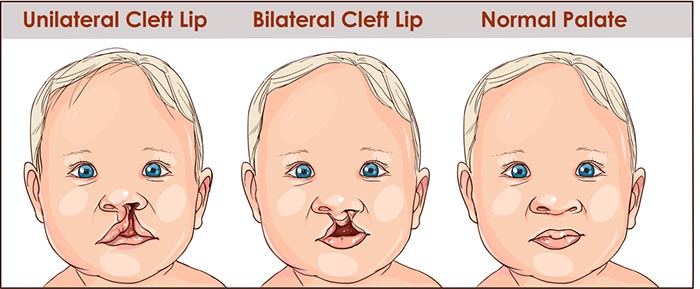Cleft Lip
What is Cleft Lip
Clefts of the lips are one of the most commonly seen conditions affecting the face in newborn babies. Clefts occur somewhere between 1 in 500 to 1 in 2000 births, depending on the race of the parents. Children can be born with just a cleft lip, a cleft lip and palate, or just a cleft palate. Most commonly, 50% of the time, the cleft patient has components of both cleft lip and palate. The cleft lip can be incomplete, complete or bilateral.
A cleft lip is a separation in the lip that results from a disturbance in lip growth during the first trimester of development. The parts of the lip that are separated vary from child to child. Some children can simply have a notching or cleft in the lip. This notching can vary in degree and is called an incomplete cleft. Other children have a complete separation of the lip that extends all the way up into the nose. This is called a complete cleft lip. This type of cleft often distorts the nose as well. Clefts of the lip can be on one side (unilateral) or on both sides (bilateral) of the lip.

Treating Cleft Lip
The cleft in the lip commonly affects the nose on that side causing it to be wide and flattened. Modern cleft care today focuses on techniques to improve the nose contour prior to surgery in hopes of avoiding secondary nasal deformities. Different devices (NAM, Lathem, and nasal retainers) can be used in the first few months of life to improve the gumline and shape the nose. The timing for the lip repair is most often between 3-4 months of age. The traditional rule has been that the baby should be ten weeks old, and weigh at least ten pounds for safe administration of anesthesia.
The procedure itself can take anywhere from 2-4 hours depending on what structures are involved and what needs to be repaired. At the end, your child is returned to you and you will stay in the hospital until you feel comfortable going home (usually between 4-24 hours). There will be medical superglue covering the lip and a nasal stent in the nose. The stent will come out in a few weeks and the glue should fall off within 7-10 days. All the stitches are disolvable and there is no need to take them out. Elbow restraints will be in place and are recommended for the next 7-10 days. Your child can use bottles and pacifiers immediately.
Schedule a time to come visit with our experienced doctors and get your questions answered.
From the Blog
Congratulations!
Welcome Utah's newest Cleft and Craniofacial certified team. After a very extensive review of the Cleft and Craniofacial Institute of Utah's team members, treatment protocols, and outcomes, the American Cleft Palate-Craniofacial Association gave its approval and...


